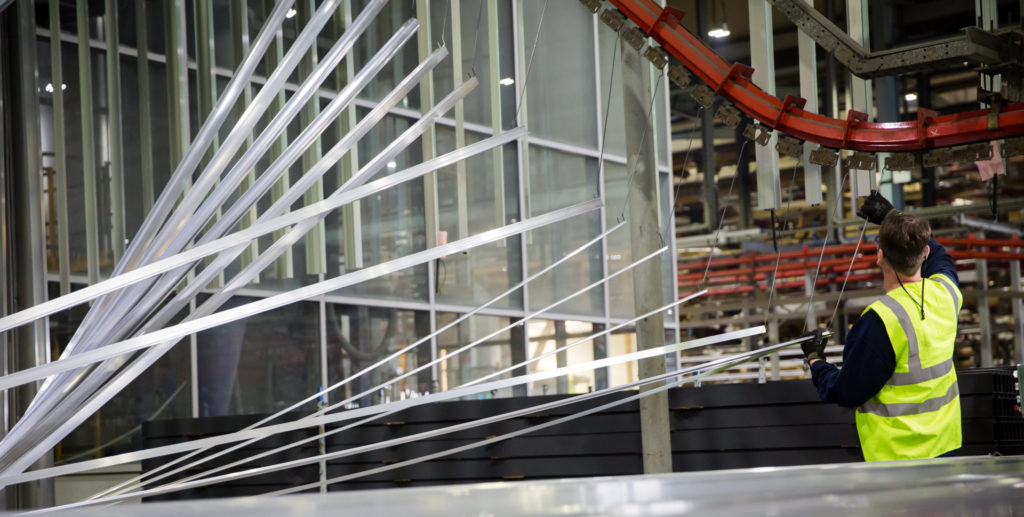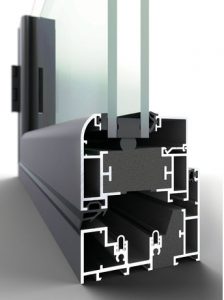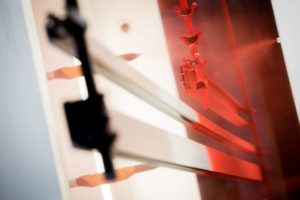 Aluminium has been called a ‘magical metal’. Mainly found as Bauxite ore, it’s the third most common element in the earth’s crust and the most abundant metal on the planet. But what makes it perfect for use in windows, doors and curtain walling?
Aluminium has been called a ‘magical metal’. Mainly found as Bauxite ore, it’s the third most common element in the earth’s crust and the most abundant metal on the planet. But what makes it perfect for use in windows, doors and curtain walling?
- Light weight – Aluminium is a very light metal with a specific weight of just 2.7 g/cm3, which is about a third that of steel or copper. In fact, it’s one of the lightest commercially available metals. This makes it ideal for window and door frames, but using a lightweight frame is especially important when it comes to curtain walling. Curtain walls are not structural and are only able to carry their own weight, so the lighter the better.
- Resistant to corrosion – if you’re looking for a low maintenance window, then aluminium is your answer. That’s because when aluminium comes into contact with air, a protective layer of aluminium oxide immediately forms on the surface. This layer is extremely resistant to corrosion from anything the weather can throw at it, including acid rain, and won’t be damaged by cleaning products. And unlike timber or PVC-U frames, aluminium window frames won’t swell, crack, split or warp over the years whatever the weather. Protection from corrosion can be increased even further by anodising or painting (usually by powder coating) the surface.
- Won’t break – aluminium is both malleable and ductile – in case you’ve forgotten your GCSE chemistry, that means it can be bent or pressed into shape or drawn out into a thin wire without losing its toughness and without breaking or cracking. In other words, its pliable not brittle. In fact, aluminium is the second most malleable metal and the sixth most ductile. This is fantastic news for anyone wanting a curved curtain wall or window, as the aluminium frame profiles can easily be bent or pressed into the required shape without any danger of them breaking.
- 100% Recyclable – Aluminium is unique when it comes to recycling metals. It is 100% recyclable and the quality of recycled aluminium is identical to that of virgin aluminium. Which means it can be recycled again and again. In fact, nearly 75 percent of all aluminium ever produced is still in use today. This is good news for aluminium supply, especially when you consider that since the first industrial quantities of aluminium were produced around 100 years ago, worldwide demand for aluminium has grown to around 29 million tons per year. But it’s even better news for the environment, because whilst it takes 14,000 kWh to produce 1 tonne of new aluminium, it only takes 5-10% of this to remelt and recycle the same amount. Which means a smaller carbon footprint and lower costs.
- Very strong – aluminium alloys are used to make window door and curtain wall frames. That’s because pure aluminium on its own doesn’t have a high tensile strength. However, once it is alloyed with other elements like manganese, silicon, copper and magnesium its strength increases vastly. The tensile strength of pure aluminium is around 90 MPa but can be increased to over 690 MPa as an alloy. In fact, Aluminium which as we’ve already seen is one of the lightest engineering metals, has a far better strength to weight ratio than steel when used as an alloy. Even more impressive, unlike steel, the strength of aluminium increases the colder it gets, whereas steel becomes brittle at low temperatures (below 0oC). This means that aluminium windows, doors and curtain walling can more than cope with the most extreme winter temperatures in the UK. The lowest temperature recorded in the UK was -27.2°C in Scotland.
- Readily forms alloys – as we’ve already seen aluminium is usually alloyed with other elements to improve its physical properties. For example, the strength of pure commercial aluminium can be increased by 20% by simply adding manganese. Aluminium also readily forms alloys with silicon, copper, zinc, iron and magnesium. This means it is possible to produce a range of alloys with properties tailored to particular applications. Aluminium glazing firms use alloys of aluminium with silicon and magnesium which are an excellent choice for extruding aluminium profiles. They are very versatile, heat treatable, highly formable, weldable and have high strength plus excellent corrosion resistance.
-
 Easy to make into frames – aluminium window frames are made using an extrusion process i.e. by forcing the pre-heated aluminium alloy through a die to create an aluminium profile. These profiles are then joined together to form the frame. It is the design of these profiles that gives the window frame its unique characteristics. They can be complex designs but thankfully these intricate shapes can be achieved using a single extruded section, so that the profiles are both strong and durable. Aluminium also has good machinability, making it easy to accurately fabricate the aluminium profiles into the finished window frame.
Easy to make into frames – aluminium window frames are made using an extrusion process i.e. by forcing the pre-heated aluminium alloy through a die to create an aluminium profile. These profiles are then joined together to form the frame. It is the design of these profiles that gives the window frame its unique characteristics. They can be complex designs but thankfully these intricate shapes can be achieved using a single extruded section, so that the profiles are both strong and durable. Aluminium also has good machinability, making it easy to accurately fabricate the aluminium profiles into the finished window frame.
- Decorative – aluminium can be easily anodized or powder coated to give it a decorative smooth or textured finish. This means that aluminium windows, doors and curtain walling not only perform well but look fantastic too. Anodising is carried out by immersing the aluminium in an acid electrolyte bath and passing an electric current through it. This converts the metal surface into a decorative, durable, corrosion-resistant, aluminium oxide finish. The aluminium oxide is fully integrated with the underlying aluminium, so that it cannot chip or peel, making it amazingly durable. The aluminium oxide has a porous structure so needs to be sealed to make it resistant to corrosion. The sealant can be clear or contain special dyes so that anodized aluminium is available in a wide range of colours.
 The alternative is to powder coat the aluminium with paint. The aluminium is pre-treated either by anodizing or via a chemical reaction to form a corrosion resistant barrier, and can then be powder coated in any RAL colour. At Senior Architectural System we have a state-of-the-art powder coating facility at Denaby. The pre-treated aluminium bars are earthed and the paint powder is given an electrostatic charge as it leaves the guns. This helps the powder molecules to stick to the bars via electrostatic charge, just like dust particles stick to your TV due to the electrostatic charge on the screen! The bars are then cured in an oven where the powder melts and forms a uniform, flexible and smooth finish which is resistant to weathering for 25 years.
The alternative is to powder coat the aluminium with paint. The aluminium is pre-treated either by anodizing or via a chemical reaction to form a corrosion resistant barrier, and can then be powder coated in any RAL colour. At Senior Architectural System we have a state-of-the-art powder coating facility at Denaby. The pre-treated aluminium bars are earthed and the paint powder is given an electrostatic charge as it leaves the guns. This helps the powder molecules to stick to the bars via electrostatic charge, just like dust particles stick to your TV due to the electrostatic charge on the screen! The bars are then cured in an oven where the powder melts and forms a uniform, flexible and smooth finish which is resistant to weathering for 25 years.
With so much going for it, no wonder more and more people are choosing aluminium windows, doors and curtain walling for both commercial and residential buildings.

Comments are closed.